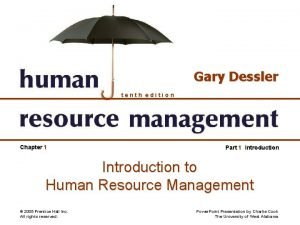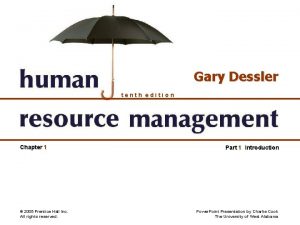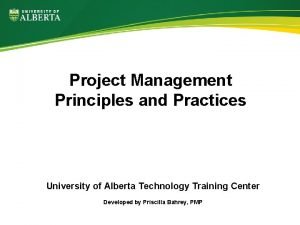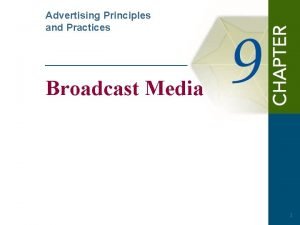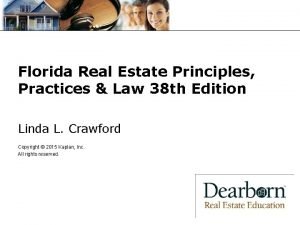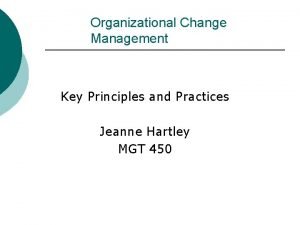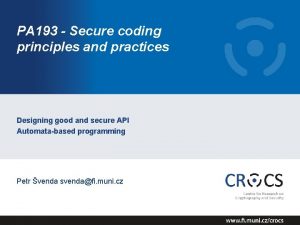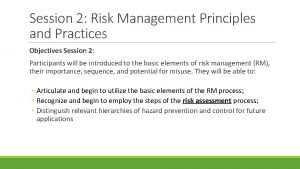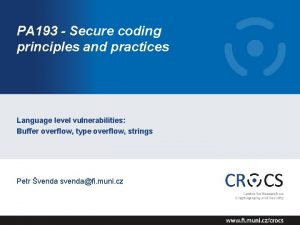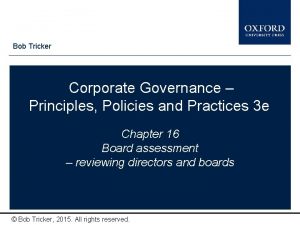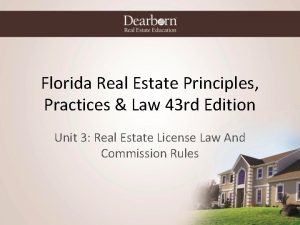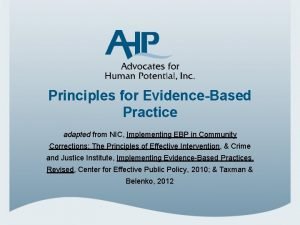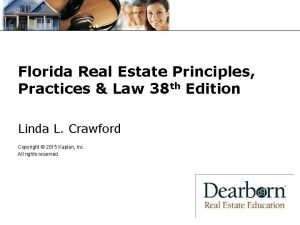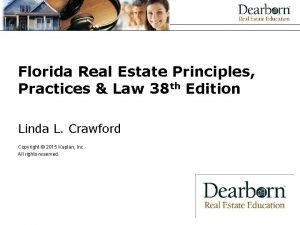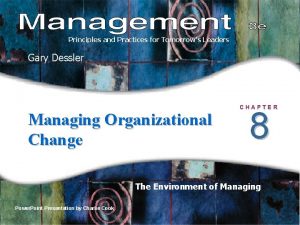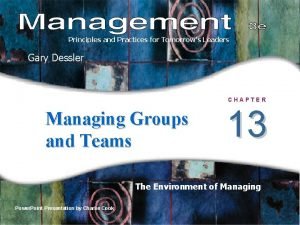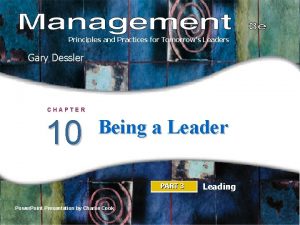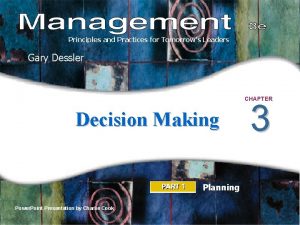Principles and Practices for Tomorrows Leaders Gary Dessler



































- Slides: 35

Principles and Practices for Tomorrow’s Leaders Gary Dessler CHAPTER Managing Entrepreneurial Organizations 16 Managing in Action Power. Point Presentation by Charlie Cook

Chapter Objectives After studying this chapter and the case exercises at the end, you should be able to: 1. Explain why you do (or do not) have the traits to be an entrepreneur. 2. List what the entrepreneur is doing right and doing wrong with respect to starting the business. 3. List what the person did right and did wrong with respect to buying a franchise. 4. Conduct an informal business feasibility study. Copyright © 2004 Prentice Hall. All rights reserved. 2

Chapter Objectives (cont’d) 5. Recommend a start-up structure for the new business. 6. List the activity areas for which the new business owner should establish controls. Copyright © 2004 Prentice Hall. All rights reserved. 3

Entrepreneurship Today • Entrepreneurship Ø The creation of a business for the purpose of gain or growth under conditions of risk and uncertainty. • Entrepreneur Ø Someone who creates new businesses for the purpose of gain or growth under conditions of risk and uncertainty. Copyright © 2004 Prentice Hall. All rights reserved. 4

Common Themes in Definitions of Entrepreneurship Source: From Mary Coulter, Entrepreneurship in Action (Upper Saddle River, NJ: Prentice Hall, 2001), p. 4; based on W. B. Gartner, “What Are We Talking About When We Talk About Entrepreneurship? ” Journal of Business Venturing 5, 1990, pp. 15– 28. Copyright © 2004 Prentice Hall. All rights reserved. FIGURE 16– 1 5

Entrepreneurs and Small Business Management • Small Business Management Ø Planning, organizing, leading, and controlling a small business. • SBA Definition of a Small Business Ø Manufacturing or wholesaling firms with fewer than 100 employees. Ø Retailing or service firms with annual sales under $5 million. Copyright © 2004 Prentice Hall. All rights reserved. 6

Copyright © 2004 Prentice Hall. All rights reserved. 7

Business Turnover, 1990– 2000 Sources: U. S. Small Business Administration, Office of Advocacy from data provided by the U. S. Bureau of the Census and U. S. Department of Labor, ETA (1999 and 2000 were estimated by Advocacy). Copyright © 2004 Prentice Hall. All rights reserved. FIGURE 16– 2 8

Why Entrepreneurship Is Important • Small businesses account most of the 600, 000 new businesses created every year. • Small firms account for 75% of the employment growth in the U. S. economy. • More than half the people working in the United States work for small firms. • Small firms generate 24 times more innovations per R&D dollars spent than do Fortune 500 firms and account for over 95 percent of new product development. Copyright © 2004 Prentice Hall. All rights reserved. 9

Corporate Intrapreneurship • Intrapreneurship Ø The development, within a large corporation, of internal markets and relatively small autonomous or semiautonomous business units that produce products, services, or technologies that employ the firm’s resources in a unique way. Copyright © 2004 Prentice Hall. All rights reserved. 10

Should You Be an Entrepreneur? • Are you a self-starter? • How well do you get along with different personalities? • How good are you at making decisions? • Do you have the physical and emotional stamina to run a business? • How well do you plan and organize? • Is your drive strong enough to maintain your motivation? • How will the business affect your family? Copyright © 2004 Prentice Hall. All rights reserved. 11

Getting Started In Business • The Idea for What Business Should I Be In Ø Work experience Ø Serendipity Ø Hobbies Ø A systematic search for ideas • Things to Consider Ø List the reasons for wanting to go into business. Ø Determine what business is right for you. Ø Identify the niche your business will fill. Ø Conduct a pre-business review. Copyright © 2004 Prentice Hall. All rights reserved. 12

Methods for Getting into Business • Family-Owned Business • Starting a Business from Scratch • Buying a Business • Buying a Franchise Copyright © 2004 Prentice Hall. All rights reserved. 13

Buying an Existing Business Pros Cons • Reduces risk of failure. • Allows immediate entry into business. • Purchaser gains the benefits of the firm’s established reputation and customer goodwill. • Can be a costly way to enter a business • Has risk in unknowingly buying a failing business • Existing problems with suppliers, customers, and employees Copyright © 2004 Prentice Hall. All rights reserved. 14

Buying a Franchise • Franchise Ø A license to use a company’s business ideas and procedures and to sell its goods or services. • Franchiser Ø A firm that licenses other firms to use its business idea and procedures and to sell its goods or services in return for royalty and other types of payments. • Franchisee Ø A firm that obtains a license to use a franchiser’s business ideas and procedures, and an exclusive right to sell the franchiser’s goods or services in a specific territory. Copyright © 2004 Prentice Hall. All rights reserved. 15

Buying a Franchise (cont’d) • Franchisee Ø A firm that obtains a license to use a franchiser’s business ideas and procedures, and an exclusive right to sell the franchiser’s goods or services in a specific territory. • Franchising Agreement Ø A document that lays out the relationship between the franchiser and franchisee. Copyright © 2004 Prentice Hall. All rights reserved. 16

Forms of Business Ownership • Sole Proprietorship Ø Simplest form of business: a business owned entirely by one person. Ø As sole owner, the proprietor owns the firm and its profits (or losses) outright; there are no other owners with whom the rewards must be shared. Ø The sole proprietor has unlimited financial liability. v The business owner is responsible for any claims against the firm that go beyond what the owner has invested in the business. Ø Profits are taxed as simple income to the owner. Copyright © 2004 Prentice Hall. All rights reserved. 17

Forms of Business Ownership (cont’d) • Partnership Ø An association of two or more persons to carry on as co-owners of a business for profit. • Partnership Agreement Ø An oral or written contract between the owners of a partnership. It identifies the business, and it lays out the partners’ respective rights and duties. • Partnership Advantages Ø Simple to start Ø More sources of investments Ø More opportunities to specialize Copyright © 2004 Prentice Hall. All rights reserved. 18

Forms of Business Ownership (cont’d) • Basic Forms of Partnerships Ø General partnership v All partners share in the ownership, management, and responsibility for all liabilities of the firm. Ø Limited partnership v Certain partners are liable for the debts of the firm only to the extent of their financial investment in the firm. Copyright © 2004 Prentice Hall. All rights reserved. 19

Partnerships • Advantages Ø Simple to start Ø More sources of investments Ø More opportunities to specialize Ø Profits taxed as simple income to the partners Copyright © 2004 Prentice Hall. All rights reserved. • Disadvantages Ø Unlimited liability for general partners Ø Personal disagreements among partners Ø Withdrawal of partners and their investments 20

The Corporation • Corporation Ø A legally chartered organization that is a separate legal entity apart from its owners. Ø A corporation comes into being when the incorporators (founders) apply for and receive a charter from the state in which the firm is to reside. Ø The corporation’s owners as stockholders also have limited financial liability for the corporation. Copyright © 2004 Prentice Hall. All rights reserved. 21

The Corporation • Advantages Ø Limited liability Ø Easier to raise capital Ø Permanence Ø Easy of transfer of ownership Copyright © 2004 Prentice Hall. All rights reserved. • Disadvantages Ø Double taxation of corporate income and dividends Ø Subject to state and Federal regulations 22

Getting Funded: Equity • Angels Ø Wealthy individuals interested in the high-risk/highreward potentials of new venture creation. • Venture Capitalists (VCs) Ø Professionally managed pools of investor money that specialize in evaluating new venture opportunities and taking equity stakes in worthy businesses. • Initial Public Offering (IPO) Ø When a company first sells stock to outside owners. Copyright © 2004 Prentice Hall. All rights reserved. 23

Getting Funded: Debt • Commercial Sources of Debt Ø Credit lines and business loans from banks Ø Business credit card debt Ø Personal loans Ø Personal credit card debt. • Asset-based Debt Ø Debt collateralized (guaranteed) by one or more specific assets of the business. If the business doesn’t pay, the lender takes the asset. Copyright © 2004 Prentice Hall. All rights reserved. 24

How Entrepreneurs Craft Strategies 1. Screen out losers quickly. 2. Minimize the resources devoted to researching ideas. 3. Don’t wait for all the answers, and be ready to change course. Copyright © 2004 Prentice Hall. All rights reserved. 25

Checklist 16. 1 Is the Business Idea Feasible? þ The Market þ The Customers þ The Industry Copyright © 2004 Prentice Hall. All rights reserved. 26

Note: (1) The ratings values are as follows: 1 = major weakness, 2 = minor weakness, 3 = minor strength, 4 = major strength. (2) As indicated by the total weighted score of 2. 8, Competitor 3 is weakest. (3) Only eight critical success factors are included for simplicity; this is to few in actuality. Source: Fred R. David, Strategic Management (Upper Saddle River, NJ: Prentice Hall, 2001), p. 115. Copyright © 2004 Prentice Hall. All rights reserved. 27

The Business Plan • Business Plan Ø A plan that lays out what the business is, where it is heading, and how it plans to get there. • Creating a Business Plan 1. 2. 3. 4. Clearly define the business. Provide evidence of management capabilities. Providing evidence of marketing capabilities. Offer an attractive financial arrangement. Copyright © 2004 Prentice Hall. All rights reserved. 28

Contents of a Good Business Plan INTRODUCTION A basic description of the firm—name, address, business activity, current stage of development of the firm, and plans for the future. EXECUTIVE SUMMARY An overview of the entire business plan, summarizing the content of each section and inviting the reader to continue. INDUSTRY ANALYSIS A description of the industry the firm is competing in, focusing on industry trends and profit potential. MANAGEMENT SECTION A description of the management team and whether it is complete—and, if not, when and how it will be completed. MANUFACTURING SECTION A description of the complexity and logistics of the manufacturing process and of the firm’s production capacity and current percentage of capacity use. Source: William F. Schoell, Gary Dessler, and John A. Reinecke, Introduction to Business (Boston: Allyn & Bacon, 1993), p. 176. Copyright © 2004 Prentice Hall. All rights reserved. FIGURE 16– 5 a 29

Contents of a Good Business Plan (cont’d) PRODUCT SECTION A description of the good or service, including where it is in its life cycle (for example, a new product or a mature product); of future product research and development efforts; and of the status of patent or copyright applications. MARKETING SECTION A marketing plan, including a customer profile, an analysis of market needs, and a geographic analysis of markets; a description of pricing, distribution, and promotion; and an analysis of how the firm’s marketing efforts are different from competitors’ efforts. FINANCIAL SECTION Financial statements for the current year and the three previous years, if applicable; financial projections for the next three to five years; and assumptions for sales, cost of sales, cash flow, pro forma balance sheets, and key statistics, such as the current ratio, the debt/equity ratio, and inventory turnovers. LEGAL SECTION Form of ownership (proprietorship, partnership, or corporation) and a listing of any pending lawsuits filed by or against the firm. Source: William F. Schoell, Gary Dessler, and John A. Reinecke, Introduction to Business (Boston: Allyn & Bacon, 1993), p. 176. Copyright © 2004 Prentice Hall. All rights reserved. FIGURE 16– 5 b 30

Staffing the Small Business • Human Resource Tasks for the Entrepreneur Ø Write job descriptions. Ø Have a recruiting plan showing the jobs to recruit for and how to recruit for them. Ø Effectively interview and screen candidates. Ø Train, appraise, and discipline the new employees. Ø Know federal and local equal employment laws. Copyright © 2004 Prentice Hall. All rights reserved. 31

Organizational Charts as a Company Grows Source: Peggy Lambing and Charles R. Kuehl, Entrepreneurship (Upper Saddle River, NJ: 2000), p. 44. Copyright © 2004 Prentice Hall. All rights reserved. FIGURE 16– 6 32

Organizational Culture: A Comparison Source: Adapted from J. Cornwall and B. Perlman, Organizational Entrepreneurship (Homewood, IL: Irwin, 1990). Copyright © 2004 Prentice Hall. All rights reserved. FIGURE 16– 8 33

What to Control? (Financials) • All approvals for disbursements of cash and regular accounting • The review of cash receipts, including reconciliation with the work that the firm actually did for the customer • The reconciliation of bank statements • The periodic review and reconciliation of inventory records • The approval of pricing policies and exceptions • The approval of credit policies and exceptions Copyright © 2004 Prentice Hall. All rights reserved. • The review of all expenses and commissions • The approval of purchasing and receiving policies • The review of payments to vendors and employees • The approval of signature authorities for payments (in other words, who can sign checks? ) • The review and changes to policies 34

What to Control? (Operations) • New orders and backlog (weekly, monthly) • Shipments/sales (weekly, monthly) • Employment (monthly) • Inventory that is out of stock (weekly, monthly) • Product quality (weekly, monthly) Copyright © 2004 Prentice Hall. All rights reserved. • Accounts receivable aging (who owes what, and for how long? ) • Weekly overdue accounts • Returns and allowances (monthly) • Production (weekly, monthly) 35
 Line and staff aspects of hrm
Line and staff aspects of hrm Gary dessler hrm notes
Gary dessler hrm notes Interview in human resource management
Interview in human resource management Roi metrics
Roi metrics Tomorrow's technology and you
Tomorrow's technology and you Planning alternative tomorrows with hope
Planning alternative tomorrows with hope Planning alternative tomorrows with hope
Planning alternative tomorrows with hope Planning alternative tomorrows with hope
Planning alternative tomorrows with hope Tomorrows doctors
Tomorrows doctors All tomorrows mbti
All tomorrows mbti House e dessler propõem 4 tipos específicos de liderança
House e dessler propõem 4 tipos específicos de liderança Alexander fleming
Alexander fleming Dessler 2008
Dessler 2008 Dessler 2005
Dessler 2005 Security program and policies principles and practices
Security program and policies principles and practices Security program and policies principles and practices
Security program and policies principles and practices Security program and policies principles and practices
Security program and policies principles and practices Security program and policies principles and practices
Security program and policies principles and practices Security program and policies principles and practices
Security program and policies principles and practices Project management practices and principles
Project management practices and principles Broadcasting principles and practices
Broadcasting principles and practices Florida real estate principles practices & law
Florida real estate principles practices & law Project management principles and practices
Project management principles and practices Change management principles and practices
Change management principles and practices State regulatory agencies milady
State regulatory agencies milady Current issues in classroom testing
Current issues in classroom testing Secure coding principles and practices
Secure coding principles and practices Purpose of summative assessment
Purpose of summative assessment Risk management principles and practices
Risk management principles and practices Secure coding principles and practices
Secure coding principles and practices Corporate governance principles policies and practices
Corporate governance principles policies and practices Tourism: principles, practices, philosophies
Tourism: principles, practices, philosophies Involuntary inactive real estate license florida
Involuntary inactive real estate license florida 8 principles of evidence based practices
8 principles of evidence based practices Florida real estate principles practices & law
Florida real estate principles practices & law Ostensible partnership real estate
Ostensible partnership real estate



